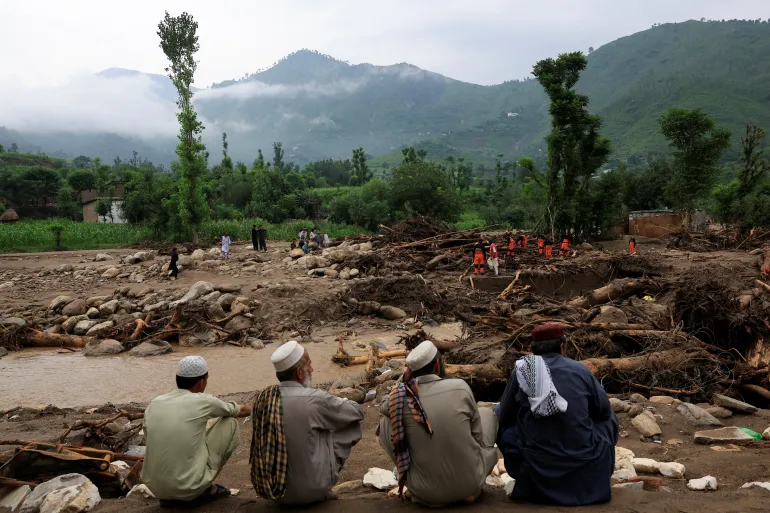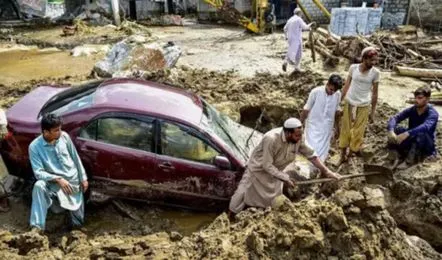Pakistan Floods 2025: Over 650 Dead as Monsoon Rains Devastate the Nation
Pakistan is reeling from yet another natural disaster. Since late June, the nation has been ravaged by intense monsoon rains, causing significant destruction. Dawn, one of Pakistan’s top newspapers, reports that since June 26, rain-related incidents have claimed the lives of over 650 people. Communities are now vulnerable and finding it difficult to cope as a result of the destruction of homes, roads, and farmland, and thousands more have been injured.

It has been called one of the deadliest monsoon seasons in recent memory. The number of fatalities is rising daily, and the extent of the damage is becoming more and more obvious. In addition to taking lives, the floods have destroyed crops, uprooted innumerable families, and overburdened the nation’s already overburdened infrastructure.
Rising Human Toll
Incessant rainfall since June 26 has caused flash floods, landslides and widespread urban flooding in various provinces. Rural areas, especially Sindh and Balochistan, have been the worst affected. Houses made of mud and clay have collapsed under the weight of water, leaving many families homeless.
According to local officials, many of the deaths were caused by roof collapses, electrocution and being swept away by floodwaters. In some areas, entire villages were submerged, forcing residents to flee with all their belongings. The growing human loss has sparked concern domestically and internationally.
UN Response and Global Solidarity
As the crisis deepens, UN Secretary-General Antonio Guterres has expressed his sorrow at the growing number of casualties. Through his spokesman Stephane Dujarric, Guterres expressed condolences to the families of the victims and expressed solidarity with those affected. His statement stressed that UN teams are with the Government of Pakistan to provide assistance if needed.As the crisis deepens, UN Secretary-General Antonio Guterres has expressed his sorrow at the growing number of casualties. Through his spokesman Stephane Dujarric, Guterres expressed condolences to the families of the victims and expressed solidarity with those affected. His statement stressed that UN teams are with the Government of Pakistan to provide assistance if needed.
This international response reflects the seriousness of the disaster. Pakistan has been appealing for help, and global humanitarian agencies are assessing how best to deliver aid in the form of food, medicine, tents, and rescue support.
Why Pakistan is Vulnerable
The scale of the devastation has once again highlighted Pakistan’s vulnerability to climate-related disasters. Although monsoon rains are an annual occurrence, their intensity has increased significantly in recent years. Poor urban planning, inadequate drainage systems and encroachment of residential areas in flood-prone areas have further exacerbated the damage.
Experts also point to the wider impacts of climate change. Pakistan has often ranked among the top 10 countries most affected by extreme weather events. Rising global temperatures, changing rainfall patterns and melting Himalayan glaciers have combined to make floods and droughts more frequent and more devastating.
Regional Impact
The floods have had a widespread impact across the region. Transport routes have been cut off in many areas, delaying not only rescue operations but also the movement of essential goods. Crops have been destroyed on a large scale in Sindh and Punjab, considered Pakistan’s granaries, raising concerns about food security in the coming months.
Meanwhile, health experts are warning of the spread of waterborne diseases such as cholera, diarrhoea and malaria. Stagnant water due to floods becomes a breeding ground for mosquitoes, while limited access to clean drinking water puts communities at risk of epidemics.
Government’s Response
The Pakistan government has deployed the army and disaster response teams to carry out rescue operations. Trapped residents are being evacuated from rooftops and flooded fields by helicopters, while medical camps are being set up in temporary shelters.
Despite these efforts, the magnitude of the disaster has completely drained the country’s resources. Relief agencies are complaining of a lack of adequate funding and logistical support. Many displaced families are still waiting for tents, food and clean water.
Historical Context
This is not the first time Pakistan has faced devastating floods. The devastating floods of 2010 devastated large parts of the country, killing more than 1,700 people and displacing more than 20 million. That disaster was described as one of the worst in the country’s history.
Comparisons are now being made between the current crisis and past crises. The fact that Pakistan continues to suffer such massive devastation shows that lessons from past disasters have not been fully implemented. Stronger infrastructure, better flood management systems and long-term climate change-resilient planning are urgently needed.
The Human Stories
Behind these statistics lie real human tragedies. Families who have lost loved ones are also grappling with the loss of their homes and livelihoods. Farmers helplessly watch their fields submerge, knowing that even after the waters recede, it will be months before they can cultivate again.
Children, in particular, are most vulnerable. Their education has been disrupted as schools have been damaged or turned into makeshift shelters. Relief workers report that children are suffering from shock, hunger and disease, and their families are struggling to find stability in relief camps.
International Aid Needed
As the scale of the crisis grows, the need for international assistance becomes clearer. Pakistan’s economic challenges, including inflation and debt pressures, mean that the government alone cannot bear the burden of rehabilitation. Global donors, aid agencies, and neighboring countries will need to step in with support.
Aid is required in multiple forms: immediate relief such as food and medicine, mid-term needs such as shelter and health services, and long-term rehabilitation such as rebuilding homes and restoring farmland. Without sustained support, the recovery process could stretch over years, leaving millions of people vulnerable.
Lessons for the Future
The current disaster must serve as a wake-up call for Pakistan and the world. Climate change is intensifying weather patterns, making floods, droughts, and storms more destructive. Countries like Pakistan, which contribute minimally to global greenhouse gas emissions, often face the harshest consequences.
For Pakistan, this means prioritizing disaster preparedness. Stronger flood defenses, better drainage in cities, and investment in climate-resilient infrastructure are essential. For the world, it underscores the urgency of addressing climate change collectively.
Way Forward
The deadly monsoon floods in Pakistan, which have claimed over 650 lives since June 26, are a stark reminder of nature’s fury and the fragility of human systems. Entire communities have been upended, families displaced, and livelihoods destroyed. While the government, army, and relief workers are doing their best to respond, the scale of destruction demands a stronger and more coordinated effort, both domestically and internationally.
UN Secretary-General António Guterres’ words of solidarity reflect the global recognition of Pakistan’s plight. But words must translate into action. The tragedy unfolding in Pakistan is not just a national crisis but a global warning about the realities of climate change. Only through preparedness, resilience, and international cooperation can such devastating human losses be prevented in the future.
Follow us for more news at Valleynewz.com

